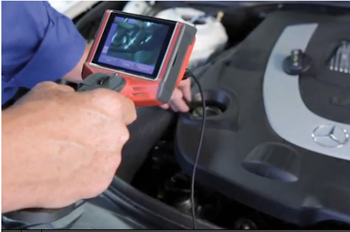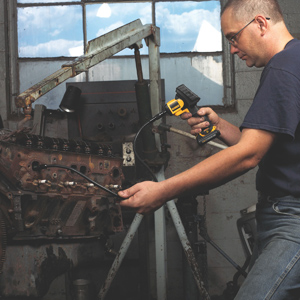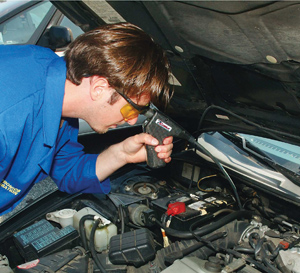As a professional technician, you have to rely on at least four, if not all five, of your senses to diagnose and repair vehicles. (For those of you who use taste to fix cars, more power to you! And cheers for admitting it!) Today we are going to talk about tools and equipment that can assist these senses. There are some really exciting and interesting tools available for the inspection and diagnosis of vehicles. Below you will find some details about these great tools and suggestions on how they can be used as well as what to look for when buying the tools.
WHAT’S YOUR VISION?
Your sense of sight arguably may be the most important of the five senses for a technician to do his/her job efficiently. However, even the best eyesight isn’t good enough to see in certain circumstances — finding a leak inside the tight engine compartment or getting a part number off of a module under the dash. For those times, you should consider purchasing and using a “scope.” These specialty devices allow the user to look into small areas that would be impossible to see without the tool.
Before we speak about the tools and their applications, let’s review a little history as to how they got to where they are today. The automotive repair industry borrowed a page out of the medical journals — doctors and surgeons have been using specialty scopes or borescopes for many years in the operating room.
The first borescopes marketed to the automotive market actually were medical devices. These first-generation tools were very high quality devices made out of surgical stainless steel with precision optics, incredible quality and, unfortunately, a price tag that would cause even the hardiest of souls to go into instant sticker shock.
 Because of the price tag on the earliest scopes, these tools were reserved for the use of dealership technicians, machinists and a few elite “toolies” who had credit lines larger than the budget of some third-world countries. However, this all began to change in the middle to late ’90s. As vehicles and engine compartments became smaller and more difficult to inspect, the demand and need for affordable tools grew.
Because of the price tag on the earliest scopes, these tools were reserved for the use of dealership technicians, machinists and a few elite “toolies” who had credit lines larger than the budget of some third-world countries. However, this all began to change in the middle to late ’90s. As vehicles and engine compartments became smaller and more difficult to inspect, the demand and need for affordable tools grew.
Out of this demand a new group of affordable inspection scopes was introduced to the automotive aftermarket. These new scopes allowed automotive technicians access to confined areas and the ability, for example, to look in piston bores via the spark plug opening. This generation of tools had many good features, but probably the best was their relatively low cost.
But, like most things in life, you get what you pay for, and it held true with the low-cost borescopes. These tools lacked some key attributes needed by technicians. Most were not articulated, meaning you could not adjust or control where the end of the probe went. This caused plenty of frustration for technicians, as they were constantly “fishing” with the scope to get the end to look at whatever they were trying to inspect. Another shortcoming of some of the low-cost scopes was the size of the end of the tool was still too large to access small openings such as injector holes on diesel engines. Finally, these tools didn’t have the ability to capture images, either still or video. Many times the technician needs the ability to document the damage for insurance purposes, or to show a customer the need for a certain repair.
 The latest generation of inspection scopes offer many, if not all, of the features and benefits needed to service today’s complex vehicles and equipment. Below are some of the key points and features you should consider when making a purchase of an inspection scope.
The latest generation of inspection scopes offer many, if not all, of the features and benefits needed to service today’s complex vehicles and equipment. Below are some of the key points and features you should consider when making a purchase of an inspection scope.
Probe Size (Diameter)
This is one of the most important and perhaps the most confusing parts of choosing a new inspection scope. Like many things, there is a trade-off to be considered when choosing the tip size. While the obvious instinct is to choose the smallest tip, you should be aware that you would be giving up a significant amount of resolution. As the camera head gets smaller, you limit the amount of light that can be captured, as well as the resolution of the lens. This can be a significant issue when looking for certain types of damage or defects.
There are several kits on the market now that feature interchangeable inspection (camera) heads. This provides the best of all choices. When you really need the smallest size (currently 5.5 mm) you can use that for jobs such as accessing injector openings. For times when you can use a larger head, I would recommend the 8.5 mm head. This will access most areas and the resolution will be up to three times greater.
Image Capture
Capturing the images the borescope sees is a critical ability. If you decide that you need to record images and save them, consider which format will work best for you and your customers.
At the very least, you can get a scope that will play back images on a video screen, but you cannot save them. The next step up is a scope that can take still image digital photos. In most cases, this is all you would ever need. The most sophisticated solution would be video capture. This is a nice feature to have that will allow you to take action photos of moving equipment or video of an entire inspection process. Some models allow you to attach a voice message to the picture or video. Some units can be connected directly to a TV in the shop to show the customer or insurance company the problem and then the work that has been done.
Also think about how you want to store the images you capture. A removable media card allows you to transport and move images to a computer. This is a great way to manage digital images, and be able to e-mail the images and audio for warranty or insurance purposes.
Articulation
This is just a fancy word for a moveable tip. The ability to aim the camera is a nice feature. This can be a lifesaver when you need to see a specific part or area on something you are inspecting. This is an expensive upgrade to a video inspection scope, but can be well worth it for those times you need it. Be sure you ask your dealer to verify this feature and, if possible, let you test it out before buying such an expensive tool. This feature works very well, but takes lots of practice to get used to the way the camera “sees” things. It can be a little disorienting at first!
Power Supply
It’s worth determining if the scope you’re considering uses disposable or rechargeable batteries. If they are rechargeable, you might consider checking with your current supplier of rechargeable tools to see if they offer this one. As I mentioned in an earlier column on cordless tools, if you can avoid adding one more battery platform to your collection, that is a nice thing.
Probe Length
Be sure to check the length of the probe; this can be a critical feature for certain users. Some of the better kits offer extensions, which allow you to look in areas that would otherwise be inaccessible.
Accessories/Case
Many of the kits available today have a variety of accessory tips and adapters. Some come with white or UV lights, while others feature angle mirrors that allow you to look around corners and up under objects. These features can be lifesavers.
As you may know, these tools are relatively expensive and, like all electronics, can be susceptible to moisture, dirt and impact damage. Pick a scope that comes with its own protective blow-molded case. This will make sure the device is safe when it’s not in use.
Warranty
Make sure you know who to contact and how the tool can be repaired in the event of a problem. Again, due to the cost and complexity of the product, it’s reasonable to expect a clearly stated warranty returns process prior to purchase. Find out who is responsible for shipping charges if the tool has to be returned for repair. How long should the process take? Is the repair station in the U.S.?
With a little research, you’ll find a large selection of scope-type products to use for diagnosis and inspection. This is a great tool to add to your automotive “doctor’s bag” that will separate you from your competition.
DID YOU HEAR THAT?
Hearing is a sense that you use every day as a professional technician. You listen for a host of noises including squeaks, squeals, grinds, rattles, thumps, thuds, clatter, clinks, bangs, buzzes, creaks, hiss, hums, whines and, of course, since we are speaking about vehicles, the occasional varoom! Or is it varooms? Well, you get the picture!
There are some specialty tools that can help you listen more effectively and more safely than what I know some of you do today. OK, by a show of hands, how many of you have taken a 24” pry bar or a screwdriver and placed it against a running alternator or water pump to listen for a bad bearing? Strike one! How many of you have driven a car next to a wall or building with the door open and hanging out to listen for driveline noises? Strike two! And finally, how many of you have leaned into an engine compartment, one hand on the throttle lever, one hand on the fender with your ear down next to the valve cover as you listen for valvetrain noise at 2,000 rpms? Strike three!
So, how, you ask, do I know about such silly and potentially dangerous methods? Umm…I saw a friend do it, yeah, that’s it!
Seriously, who among us hasn’t done some silly and possibly dangerous (or deadly!) maneuvers to find noises? Probably not many! The reality is that a big part of vehicle repair is diagnosing, finding and eliminating noises. For my good friends at the dealership level with a blue oval, you even have a cute acronym for it — NVH or Noise, Vibration, Harshness. Noises are a big and not so funny part of everyday life for both dealership and independent technicians.
The pressure to find a noise on a $50,000 vehicle still under factory warranty is immense. The problem is, all you have to go on is a customer trying to mimic the vehicle’s sounds looking and sounding like they are having a seizure. I spent many years writing service for both a high line dealer as well as an indy who specialized in tires, brake and alignment repair. At least once a day we would have some car owner standing there trying to describe some noise.
There are two main groups of listening devices: active and passive. You could also call this fixed and mobile. Here’s a simple way to tell the two apart: active listening devices are generally self-contained units where the listening technology and the sensor or probe are all in one unit, or at least both move and are connected closely. Fixed listening devices are those where you attach some sort of sensor directly to a part of the vehicle you are diagnosing.
Active Listening
Mechanical Stethoscopes
Active listening devices include both electronic and non-electronic devices. The earliest example of these was a mechanical stethoscope featuring a hard probe connected to earpieces. While these tools can be effective for certain types of noise detection, they are inherently dangerous due to the fact that you are placing the business end of the tool near moving machinery. The advantage of this type of device is it’s inexpensive and it requires no set up, batteries or special handling. Some drawbacks include the lack of ability to control volume or filter out extraneous noises. All in all, still a good first-level tool and a great value based on its cost.
Electronic Stethoscopes
The next level of active listening devices is actually electronic stethoscopes that use technology and battery power to overcome some of the inherent flaws with traditional stethoscopes. By using sophisticated filtering programs, as well as improved ear cuffs, these tools are incredibly sensitive. The user can adjust the volume and filter out unwanted noises when listening for problem sounds.
This tool, while more expensive than a mechanical stethoscope, is still relatively inexpensive considering the great information available to the user.
Passive Listening
The name passive listening is used to describe the way the tool is applied or connected to the car. It simply means that once the sensors are attached to the vehicle, the user doesn’t move them again during the testing. These tools are comprised of a central control/distribution unit, a set of very sensitive headphones and anywhere from four to 10 sensors. The technician attaches the sensors to the parts of the vehicle that he suspects of making noises. The control unit and headphones can be positioned either in the car for road tests or just safely away from the area being tested. The sensors have very long leads on them that allow them to reach from the furthest point on the car into the cabin or driver’s area.
This set-up makes testing a one-person operation, and the car can be driven to simulate the conditions that the vehicle owner complained about. The technician can listen to both sides of a vehicle for comparative purposes and to eliminate possible causes of noises.
While the test method is passive only in that the technician sits still, it is one of the best diagnostic solutions available to find and repair noise-based complaints.
These two families of testers (Inspection Scopes and Listening Tools) serve to enhance, not replace you and your abilities to look at and listen to vehicles and their components. They can take some of the stress and uncertainty out of diagnosing and treating your “patients” — and that makes a lot of sense to me!




